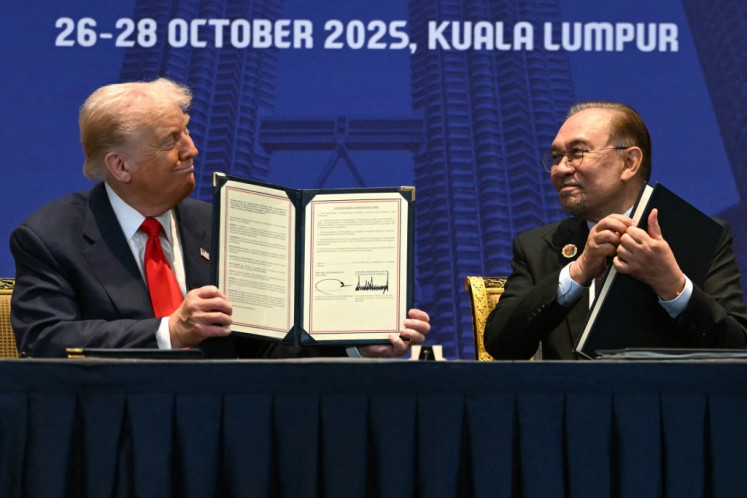Popular Reads
Top Results
Can't find what you're looking for?
View all search resultsPopular Reads
Top Results
Can't find what you're looking for?
View all search resultsLost Nazi U-Boat: Found undersea near Karimunjawa
JP/Indra HarsaputraAfter finding Ming-Dynasty ceramics in 2009 (and again in 2011), divers from the Yogyakarta Archeological Center said in November that they made another discovery: a sunken Nazi U-boat
Change text size
Gift Premium Articles
to Anyone
JP/Indra Harsaputra
After finding Ming-Dynasty ceramics in 2009 (and again in 2011), divers from the Yogyakarta Archeological Center said in November that they made another discovery: a sunken Nazi U-boat.
The discovery prompted Priyatno Hadi Sulistyarto, leader of the underwater archeologists, to examine historical documents on the German military presence in Indonesia during the World War II following the submarine's discovery.
'This is a major find in the history of World War II, during which the German forces backing up Japan turned out to have stopped over in Indonesia,' Priyatno said.
The wreck of the Nazi U-Boat was first discovered by a local fisherman, when clearing his net off the coast of Karimunjawa.
A team from the Yogyakarta Archeological Center, the Yogyakarta Diving Center and local divers quickly hired a vessel to survey the place where the debris was discovered, about 10 hours' sail from Karimunjawa.
After three dives, a 47-meter-long piece of the U-boat was found 18 meters underwater on a sand bar.
'The shipwreck was muddy, with its stern already missing,' Priyatno said. 'On board the wreck, were 17 skeletons and two German military plates bearing Nazi symbols, estimated to have been produced in 1939.'
Other items found on the vessel included uniform buttons, binoculars, diving goggles, breathing tubes, batteries, shoe soles and various pieces of electrical equipment.
'We believe the submarine had been shot because we found it in already severed,' Priyanto continued. 'Of its normal length of 76 meters, only 47 meters were left, without the rear part. We'll be diving again for further research in this year.'
According to uboat.net, U-168 sailed from Penang in February 1944 for a 47-day war patrol, sinking 2 two ships before docking in Batavia (now Jakarta).
The Nazi sub, under the command of Kapitänleutnant Helmuth Pich, left Batavia on Oct. 5, and was torpedoed and sunk by the Dutch submarine HrMs Zwaardvisch in the Java Sea a few days later.
Twenty-three of U-168's crew died in the attack, and 27 survived, including Pich, who died in 1997 at the age of 82.
The presence of German soldiers and sailors in Indonesia during the war has been well documented. There is a German military cemetery in Mega Mendung, Bogor, for example.
The 300-square-meter cemetery, where 10 Germans are interred, sits on land controlled by state plantation company PTP Nusantara VIII in Sukaresmi, about 70 kilometers south of Jakarta.
When war broke out in 1939, Germany invaded the Netherlands, which prompted an immediate response in the Dutch East Indies, where Dutch soldiers seized German citizens, including those who worked on German-owned tea estates in Java.
Germany invaded The Netherlands in 1943, paving the way for a German return to Java, which had fallen earlier to its Axis partner, Japan.
While it appears that German sailors 'retook' the estates in Sukaresmi, it is not clear if the men were from the ill-fated U-boat armada. They died and were buried in the cemetery.
Priyatno said his team was planning additional dives for 2015. 'The German Embassy has contacted us to discuss the discovery. The ship wreck remains underwater and it's now under guard by Indonesian Navy troops.'
The site contains other, less gruesome, discoveries, he added. 'European ceramics were discovered on Parang Island west of Karimunjawa, and 13th century Chinese ceramics were found on Genting Island in the east.'
The finds suggest that Karimunjawa was on the sea lanes of international commerce between the 13th and 20th centuries.










